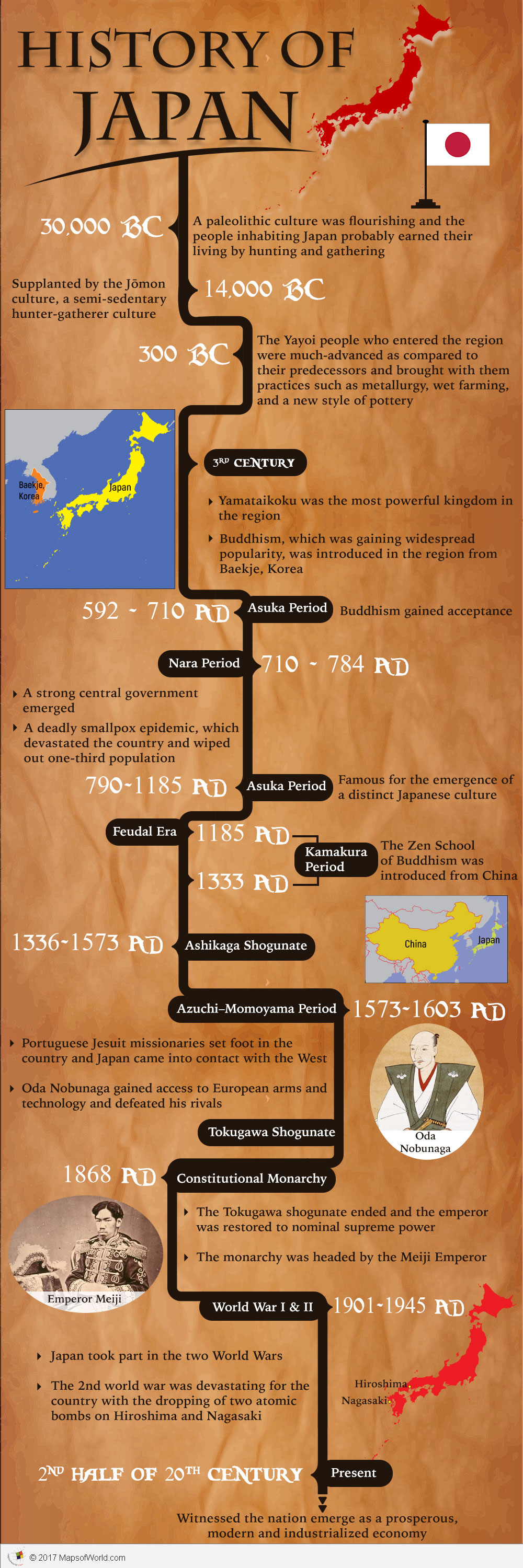How Old is Japan? History of Japan

The history of Japan dates back to prehistoric times. Japan is a very old country and it is hard to determine when civilization began in the country. In this article, we will explore how old Japan is, interesting facts and more.
How Old is Japan?
It’s difficult to pinpoint an exact age for the country of Japan. However, following key milestones can be considered to understand the age of Japan. These includes:
-
First Human Settlements in Japan (30,000 – 10,000 BC)
The earliest evidence of human habitation in Japan dates back to the Paleolithic Period (30,000 – 10,000 BC). These hunter-gatherers lived a nomadic lifestyle and used basic stone tools.
-
Jomon Period (10,000 – 300 BC)
This period is named after the characteristic cord-marked pottery made by the Jomon people. They were a settled society who lived in pit houses and subsisted on hunting, fishing, and gathering.
-
Yayoi Period (300 BC – 300 AD)
This period saw the introduction of rice cultivation and metalworking from mainland Asia. The Yayoi people also built more permanent dwellings and developed a more complex social structure.
-
Kofun Period (300 – 710 AD)
Powerful clans emerged during this period, building large burial mounds (kofun) for their leaders. This era also saw the introduction of Buddhism and the development of a writing system based on Chinese characters.
-
Yamato Period (710 – 784)
The Yamato court established itself as the dominant power in Japan during this period. They built the first permanent capital at Heijo-kyo (present-day Nara) and centralized control over the country. This period also witnessed the deadly smallpox epidemic that devastated the country and led to a massive loss of life.
-
Heian Period (784 – 1185)
The Heian period was marked by a flourishing of culture and the rise of a powerful aristocracy. Literature, poetry, and art forms like calligraphy and ink painting reached new heights. However, the power of the imperial court gradually declined towards the end of this period.
-
Kamakura Period (1185 – 1333)
In this period, military leaders (shoguns) seized power from the emperor, establishing a feudal system in Japan. Samurai warriors became the dominant class, and Zen Buddhism gained popularity.
-
Muromachi Period (1333 – 1573)
This period was marked by constant warfare between rival feudal lords (daimyo). It was also a time of cultural exchange with China, leading to the development of tea ceremony, ink painting styles, and Zen gardens.
-
Azuchi-Momoyama Period (1573 – 1603)
Powerful warlords like Oda Nobunaga and Toyotomi Hideyoshi unified much of Japan during this period. They introduced social and economic reforms and paved the way for a more stable era.
-
Edo Period (1603 – 1868)
The Tokugawa shogunate established a strict social hierarchy and a policy of isolation from the outside world. This period saw a flourishing of merchant culture, art forms like kabuki theater and ukiyo-e woodblock prints, and the development of a unique Japanese identity.
-
Meiji Restoration (1868) and Modernization
The overthrow of the Tokugawa shogunate ushered in a period of rapid modernization. Japan adopted Western technology and political systems, becoming a major world power in the early 20th century.
Interesting Facts
- Japan’s volcanic activity provides a natural timeline for its history. Layers of volcanic ash help date archaeological sites, offering a glimpse into the lives of past inhabitants.
- Rising sea levels have submerged some of Japan’s ancient settlements. Underwater archaeological investigations are revealing new insights into early Japanese life, potentially rewriting our understanding of the nation’s history.
- Some of Japan’s oldest traditions offer a living connection to the past. The art of Kabuki theater, with its roots in the 17th century, and the meticulous practice of swordsmithing, passed down through generations, showcase the enduring legacy of Japan’s rich history.
Related Links